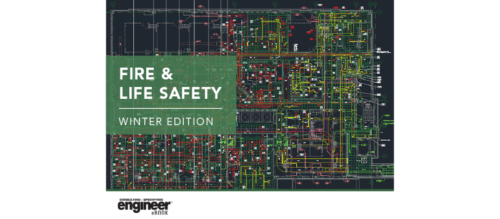Your questions answered: Integrating fire and life safety system testing
Fire and life safety system testing is defined by several codes and standards
NFPA 3: Recommend Practice for Commissioning and Integrated Testing of Fire Protection and Life Safety Systems and NFPA 4: Standard for Integrated Fire Protection and Life Safety System Testing explore integrated fire protection and life safety system testing and are vital to a building’s overall fire/life safety implementation.
Questions not answered during the webcast are answered here by the presenters:
- Brian Duhacek, PE, CET, CWBSP, Fire Protection Engineer, HDR
- William E. Koffel, PE, FSFPE, Director of Special Projects, Koffel Associates
Register for and watch the webcast on-demand: Fire, life Safety: Integrating fire and life safety system testing.
What is the static pressure should be in high-riser stairwell? Please explain the procedure for the testing.
Bill Koffel: There is no way to identify a pressure that should be in all high-rise stairwell risers. It will vary by floor. In most instances the pressure should not be greater than 175 psi since that is the pressure for which most components are listed.
There is no need to test the static pressure. The pressure gauge reading should be adequate. What is required is a flow test of the standpipe riser and if present, the pressure regulating device per NFPA 25: Standard for the Inspection, Testing and Maintenance of Water-Based Fire Protection Systems.
As an authority having jurisdiction (AHJ), is there any certification that the people who conduct these tests should hold? Such as special inspector?
Bill Koffel: Special inspector is a defined person by the International Building Code and there are specific inspections that need to be performed by a special inspector. Several NFPA standards identify the qualifications for those who perform such tests (NFPA 72: National Fire Alarm and Signaling Code) while others refer to a “qualified person.” For some tests, NICET does have a certification program.
We have witnessed a fire alarm (FA) contractor zone update reverse the results of our integrated system test (IST) previously performed. The FA contractor updates these zones as they work. How does this work with projects with phased occupancy where city inspectors ask for IST before FA system completion?
Bill Koffel: Partial occupancies are unique situations and the details need to be worked out between all stakeholders, including the AHJ. It may be appropriate for the IST to be phased, like the phased occupancy.
Who is qualified to write the integrated test plan?
Brian Duhacek: The integrated testing agent is responsible for developing of the integrated systems testing plan.
In offices building, where the fire alarm should be installed by the tenants, when shall we use T-breaker and when to use Interface unit.
Bill Koffel: There are a number of issues with tenant fire alarm systems. We have written specifications for tenant fire alarm systems that the property management company distributes to all tenants. In our specification, the tenant is responsible for inspection, testing and maintenance (ITM) for their own system and required to certify to the property management that the system has been tested. The property management company determines what needs to be connected to the building fire alarm system and is responsible for the interface with the building system.
What type of smoke testing is used for fire protection testing?
Bill Koffel: NFPA 92: Standard for Smoke Control Systems does not require that smoke control systems be tested with actual smoke. However, it is often required that smoke be used. Smoke bombs can be used but the smoke will not have the same thermal energy as a real fire. There are ways to heat the smoke but again, probably not to the same temperature as would be produced by a fire.
Would the Fire Alarm Contractor not have a financial interest if he is used as the ITM?
Bill Koffel: Yes. For that reason, the fire alarm contractor should not be the commissioning agent. However, if the systems being tested are new systems, they would also be under the oversight of the Commissioning Agent. For periodic inspection, testing and maintenance there is less of a concern about financial interest. If the owner has that concern, the integrated testing agent should be another party.
Do AHJs still require two broadband phone lines? Given the unavailability of these POTS lines, are there any alternatives?
Bill Koffel: Newer technology DACTs use a means, other than a POTS line to transmit the signal. There is also a performance-based option provided in NFPA 72.
Who is responsible for selecting the integrated system testing team?
Bill Koffel: The owner.
Are you aware of any collaboration of NFPA 4 with Canadian ULC-S1001 standard?
Bill Koffel: I am not.
What is the procedure to test a fire hydrant supplied by private fire pumps?
Bill Koffel: This is addressed by NFPA 25.
How many additional team members are needed to do integrated systems testing?
Brian Duhacek: This depends on the types of systems involved in the testing, specific project requirements and any owner and/or AHJ requirements. The testing team can include owner’s technical support personnel, facility manager or operations personnel, installing contractors, AHJ, registered design professionals, general contractor, manufacturer’s representatives, insurance representatives, third-party testing representatives, commissioning agents, integrated testing agent and fire commissioning agent.
Do NFPA 3: Standard for Commissioning of Fire Protection and Life Safety Systems and NFPA 4: Standard for Integrated Fire Protection and Life Safety System Testing cover integrated systems of systems that do not include a fire alarm system. For example, a life safety generator and emergency lighting.
Bill Koffel: Yes, although most integrated systems are likely to include a fire alarm system.
Do you have experience and expertise with the topics mentioned in this content? You should consider contributing to our CFE Media editorial team and getting the recognition you and your company deserve. Click here to start this process.





